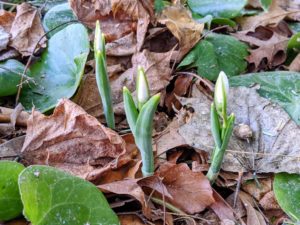Snowdrop Delight
- At March 01, 2021
- By drynick
- In Reflections
 0
0
My Love Note from February 25
When will you come
my nodding friends
alabaster snowdrops?
was answered on February 26! The flowers are still budded and not yet nodding, but that is perfectly fine with me.
I thought to look for them the day after I wrote, but was genuinely surprised to find them. There are a few secret places I know to look, where they come up every year. Usually I forget and they catch me by surprise, when spring is far from my mind with cold melting snow all around. I’ll be on a backyard excursion to check for something else and they’ll catch my eye by the path, in a patch of frozen ground. I wrote another love poem on March 18 in 2019 about snowdrops, the first flowers of the year in the Temple garden:
As the snow retreats
they surprise me every year
in the same place.
But, as I said, this year I remembered to look even while the snow blanketed 90% of the garden and grounds. And there they were by the lower entrance to the Temple. It’s not a particularly fertile part of the garden—nearly fully shaded by a spectacular crimson rhododendron that has risen beyond all reasonable rhododendron expectations and dominates the area. I have a couple painted ferns that seem to be happy underneath along with some ornamental ginger, but not much else seems to tolerate the shade and soil…except the hardy few snowdrops that return year after year.
After ten springs walking in this Temple garden, the larger patterns are just beginning to reveal themselves to me. This is the joy of gardening, to discover and work with the natural flow of things. The garden here has been a patient teacher. Though I am a slow learner, my stubborn enthusiasm keeps me around long enough to take in some small portion of the beauty and brilliance that surrounds me. The way things happen grows only slowly on and in me.
I am a great believer in the randomness of events. As we used to say in sociology, correlation is not causation—just because two events happen one after the other does not mean that one caused the other. I am a great believer in the staggering number of variables that lead to the occurrence of any single event. Freud called this overdetermination—there are a number of reasons why any particular things happens—each one is, perhaps, sufficient explanation, but not a full explanation.
Over the season and over the years things happen in a garden. Some plants flourish, some survive and many die. As a gardener, you are always working with failure and death. The plant that looked so healthy and lush at the garden center or in its glossy photo in the catalogue, looses its mojo when placed in what should be the perfect spot. Or it does well for a season or two, then mysteriously withers.
But in the middle of all the coming and going, a lot of things flourish—most of them not due to my care. I suppose that’s one of the criteria for succeeding in the Temple garden, to survive without a lot of fussing necessary. Now fussy plants are beautiful and we could also call them high relationship plants. Fussy is just the word of a lazy gardener who isn’t fully committed to the relationship.
We had a Zen student who had a thing with orchids. She would take our supermarket orchids after they had bloomed and before we took them to the compost pile. They would return several months later covered again with gorgeous blossoms. The orchids clearly delighted in her careful attention and she in theirs. The rescued plants would grace the Temple for weeks on end.
For me, however, I like the rough and tumble plants that, having found the right location, flourish with the proud neglect of a gardener who doesn’t like to work too hard—who just wants to appreciate the natural processes as they reveal themselves.
So the wild snowdrops have done quite well in the Temple garden and have finally taught me to look for them before I am even thinking about spring. I went down to the lower entrance on Friday afternoon, just on a whim because the snow was pretty much everywhere. (It was the day after writing my poem of longing for them, but usually I’m so busy longing that I forget to look for what is already here.)  There, in the small neglected area near the lower door was a small patch of ground not covered in snow. And there, to my delight and surprise, were the three first snowdrops of the year—each one just two or three inches tall, snuggled amongst the round wild ginger—holding aloft their white buds, almost ready for nodding.
There, in the small neglected area near the lower door was a small patch of ground not covered in snow. And there, to my delight and surprise, were the three first snowdrops of the year—each one just two or three inches tall, snuggled amongst the round wild ginger—holding aloft their white buds, almost ready for nodding.


Follow David!